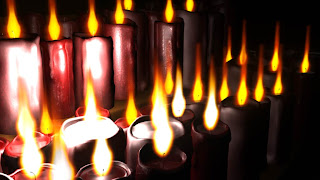In our composition, we open our scene with gentle candles light a room. Starting with a close up that is blurred in, and then cutting to a mid shot. Just after this we have a close up shot of a candle moving with an introductory shot of the emperor statue. The next time we see candles, they are being blown in the wind through the discovery of the factual situation of the ship, and finally the closing shot ends with an extinguishing fame of the last candle flame. The significance on the scenes place highly their importance in our short film. Hence trying to simulate accurately the flickering was crucial.
Analyzing the first two shots- I concluded that a smart way to go about finishing them was to create the mid shot, then create an additional camera to suit the first close up- Hence i would complete two shots in one provided that I created realistic candle light.
This was a prime example of some excellent team work. The statue was modeled by Ollie, the candles were modeled and textured by Steph, now I had to set up the lighting and the candles. This required constant communication between the group and good organization with project files etc.
Here is the image I was asked to follow.
On top of this I had to create a number of these candles similar yet unique.
At first I tried experimenting with fluid containers by creating one, caching the simulation and the replicacted it on another empty fluid container. I also considered using sprites, and image sequences but I felt that I was not able to create the uniqueness of each candle.
I decided that the best way to achieve a number of unique candles was to individually create them. Before doing this I had to create one first.
Having not been very familiar with fluids, I was overwhelmed, just as with the ocean shots, with the number of attributes that make up a fluid emission. However I used the knowledge that I gained from the ocean scenes- i.e taking a systematic approach to tweaking settings.
I eventually found that fluids have a wide range of controls to determine the way they look. One has indivual controls on the turbulence, boyancy and other key fluid attributes for values such as temperature, fuel etc.
Once I had one candle flame- I faced an even bigger problem. How to create many? I found that simple duplication did not produce the result.
I decided to make a simple script. Firstly I took all of the important candle.shape attributes needed to create the colour and feel that I wanted.
After this, I wrote a script that created candle flames of an exact type to match up with the first approved candle. I applied this script several times and placed them appropriately.
Finally I create a cool script which selected every single fluid container and the altered the "start frame" attribute from -100 to -50 frames before the desired time. This meant that every single candle flame started at a random time- meaning a slightly subtle but necessary difference between each flame.
Here are some test images and videos that show the progress of my work.
Here is the final tweak of the candle shot






















































